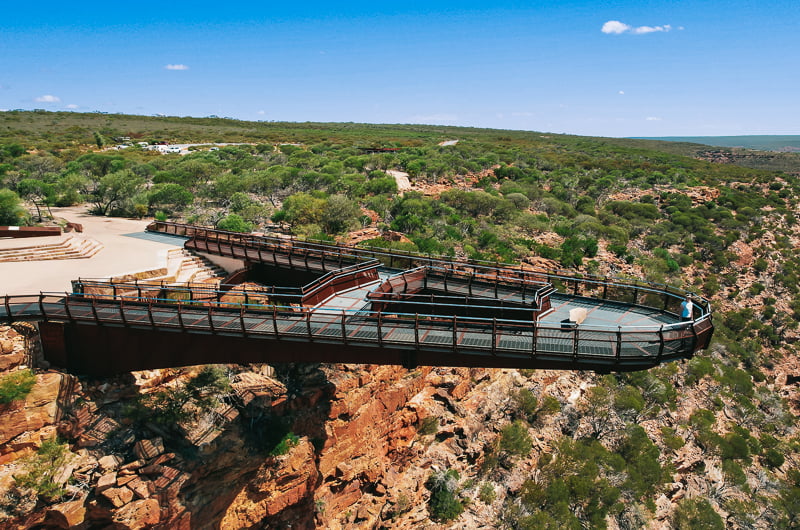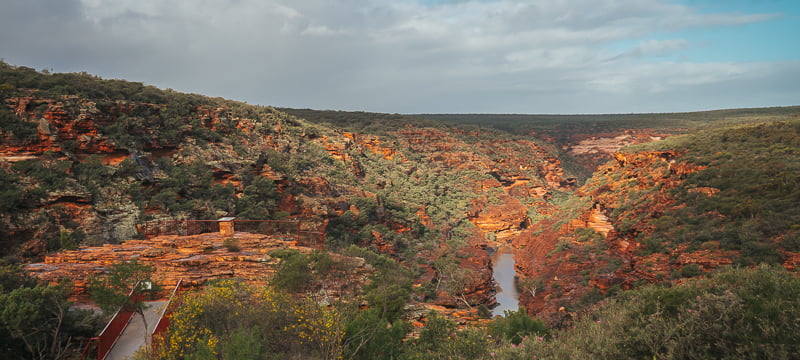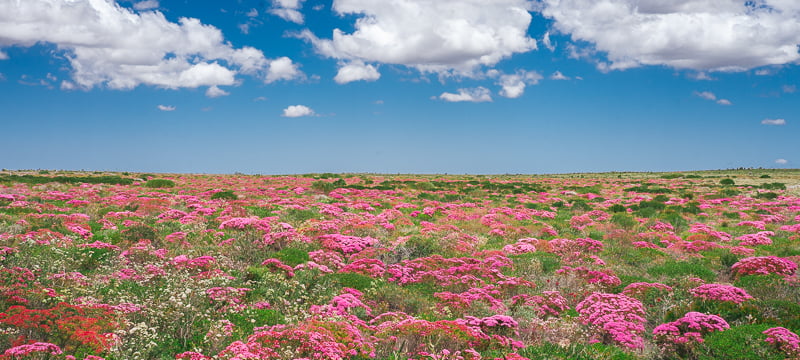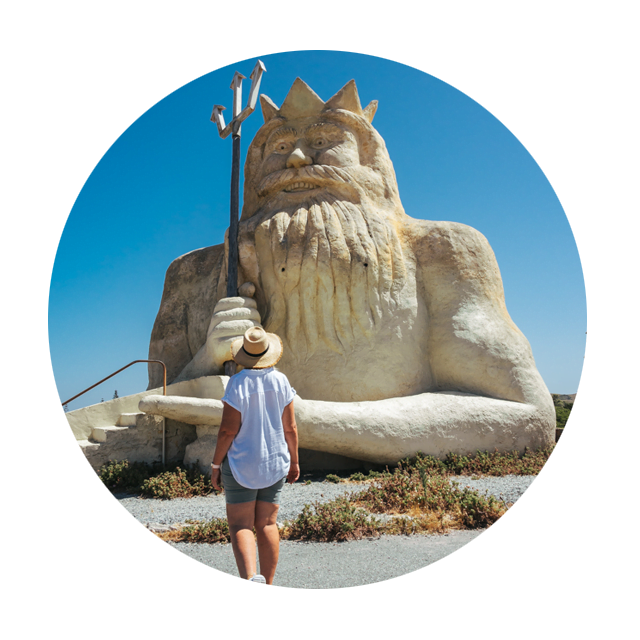Kalbarri – Our Guide on What to See And Do!

Situated on Australia’s Coral Coast where the Murchison River meets the Indian Ocean in Western Australia is the humble country town of Kalbarri. Blessed with easy access to the dramatic inland and coastal gorges of the Kalbarri National Park. A WA favourite family holiday destination, you’ll discover something for everyone – with protected swimming beaches, stunning landscapes, fishing, surfing and plenty of adventure activities.
How to get to Kalbarri from Perth?

Kalbarri is around 6-7 hours (600km) drive north of Perth in Western Australia. You’ll find the road mostly straight and in good condition, so it’s not a difficult drive. To break up the travel time, we’d suggest you stop along the way for a meal or for a night. Geraldton or Jurien Bay are great places to stay. It’s also worth dropping into The Pinnacles at Nambung National Park and Hutt Lagoon to see one of WA’s best pink lakes on this road trip.
When is it best to visit Kalbarri?

Kalbarri is blessed with year-round good weather! Similar to a Mediterranean climate, it’s hot and dry in summer and milder with some rain in winter. It is often quite windy, and be aware that the summer temperatures can soar. The inland National Park can also get 10 degrees hotter than on the coast.
The busiest months are in spring-summer and coincide with school holidays. Arguably, the best time to visit is when the wildflowers are in bloom from July to November (weather dependent). This also coincides with the humpback whale migration, so you’ll likely see whales out at sea!
What to do in Kalbarri?

Kalbarri National Park
Over 186,000 hectares in size, Kalbarri National Park encircles the township of Kalbarri and is definitely the top-rated attraction. North-east of town are inland river gorges with rock formations as old as 400 million years. The south features towering ocean cliffs plummeting to the waves below. Both offer superb walking trails and epic views.
Kalbarri National Park is very accessible, with sealed roads and well-laid paths to most of the main sights. There is an entry fee of $15 per vehicle to the inland gorges. If you are planning on visiting more national parks in Western Australia, we suggest purchasing a Park Pass. This covers unlimited entry for private vehicles for the duration of the pass.
TOP TIP: RAC members can get a discount on the Holiday Pass, Annual All Parks Pass and the Concession Annual All Parks Pass when purchased through the RAC member benefits website.
What to see in Kalbarri National Park?

Kalbarri Skywalk (Kaju Yatka)
Described as better than the Grand Canyon, the views from the twin skywalks, built 100 metres apart at the West Loop are sublime. Located in the inland gorges, the Kalbarri Skywalk is about half an hour’s drive from the township on a sealed bitumen road.
Being designed in an inverted V shape, the Skywalk’s two platforms extend 17 metres and 25 metres beyond the edge of the cliff at one of the highest points over the Murchison River gorge. With its 100-metre drop, you get a sense of floating above the canyon. Accessible to people of all ages and abilities and open 24 hours a day, it feels very solid underfoot, so even those with a fear of heights can enjoy it.
You can also learn about the traditional owners ‘Nanda’ heritage and culture through interpretive signage and artwork at the Skywalk. Discover local fauna statues, fossils and geolocation information on the 400 million-year-old sandstone that makes these gorges.
There are no additional fees to access the Skywalk precinct.
Nature’s Window

Rated as one of Western Australia’s most iconic attractions, Nature’s Window is accessed from The Loop car park in the inland gorge section of Kalbarri National Park. Formed from layers of Tumblagooda Sandstone, the natural rock window overlooks the Murchison River and gorge.
Just follow the one-kilometre return paved trail, with a bit of easy rock climbing at the end of the path. It’s well worth any effort to see this natural rock formation and the river it frames. The layered sandstone window is fragile, so people are asked not to climb above the window.
The Loop Trail continues into the ancient gorge for those who want a challenging hike. You’ll see incredible red and white layered sandstone formations (just make sure you are well prepared!). From Nature’s Window, the loop trail is about 8km and takes about 3-4 hours. Hikers should carry plenty of water.
Explore the River Trails

The Murchison River snakes its way through Kalbarri National Park. There are a number of great lookouts and walking trails to explore.
The Z-Bend Lookout has some of the best views of the park. Aptly named because of the enormous Z bend created as the river flows through the gorges. It’s a 600m walk to the Lookout (1.2 kilometres return). Or you can continue down the Z-Bend River Trail (2.6km return) to access the river. The River Trail hike can be challenging and involves descending down into the gorge by a series of ladders.

For those wanting something easier, stop at Hawks Head and Ross Graham lookouts. These two easily accessible spots are just a short walk from the car park. Named after Kalbarri’s first school teacher, Ross Graham also offers a short and easy walk from the car park to the river’s edge for a swim or to explore the glorious Murchison River on foot.
Wildflowers in Kalbarri National Park

Visiting Kalbarri during wildflower season (July through to November) is a must. Around one thousand different species of wildflowers carpet the region and it’s an incredible sight to see. Many of the flowers are unique to the region and start to bloom from late June onwards, depending on the weather. Keep an eye out for them in Kalbarri National Park as well as along the coastal cliffs. The visitor centre in Kalbarri can update you about what is flowering and where best to see them.
What to see along the Coast
Jake’s Point
If you’re into surfing then head to Jake’s Point. It is a beautiful beach popular with the locals. You’ll often find the Bean Drifting Coffee van here for your morning wake-up. If you’re a beginner, stick to surfing in between the rocks and if you’re feeling adventurous, head out with the locals to the point.

Blue Holes
The rock pools of Blue Holes create a magical spot to see many species of fish, coral, crustaceans, western rock lobsters and much more. It’s the best place in Kalbarri to snorkel or take the kids for an interactive marine exploration at low tide. The beach is lovely and it’s also a great place to swim and relax.

Chinaman’s Beach
If it’s a windy day, but you wanted to visit the beach, Chinaman’s Beach is your place to go! You’ll find turquoise blue waters where the Murchison River meets the sea. This is a lovely beach area for families and kids as it’s sheltered and safe to swim. You might even spot a dolphin!

Kalbarri National Park Coastal Cliffs
South of Kalbarri you’ll find a number of great lookouts and trails to explore. Offering walk trails with sandstone cliffs plunging more than 100 metres to the ocean, make sure to allow plenty of time to explore this remarkable expanse of rugged coastline, decaying cliffs and amazing rock formations.
Island Rock: The resilient Island Rock was once part of the shoreline, now standing as a solitary ‘sea stack’ against the forces of the ocean. Viewing platforms are a short distance from the car park, providing spectacular views of this geological oddity.

Natural Bridge: This lookout is a short walk from the carpark, where visitors can enjoy stunning coastal views. Be on the lookout for marine life, including whales and dolphins.

Red Bluff Lookout: Towering 100 metres over the ocean below, Red Bluff is the ideal spot to see humpback whales on their annual migration along the Kalbarri coastline. Named by Dutch explorer Willem de Vlamingh in 1697, the spectacular coastal cliffs extend 13 kilometres through Kalbarri National Park. The landscape with delicate threads of red rock looks like tears frozen in time in formations believed to be 400 million years old.

Mushroom Rock Trail: This Class 3 loop trail takes you on a leisurely two-hour walk down to the unusual sight of mushroom-shaped rock and the spectacular Rainbow Valley gorge. Its shape has been created by the strong winds and water eroding away the rock over many years. At dawn or dusk, you might witness kangaroos feeding amidst the coastal heath and rocky outcrops.

Pot Alley: Named by local cray fishermen after losing many pots to this hazardous cove, this 400m rocky walk trail winds down through the gorge to a secluded beach (swimming is not recommended here). It’s also a great spot to watch the sunset over the ocean. While you’re there, keep an eye out for humpback whales that migrate down the coastline. Whale-watching season runs between June and November.
Pelican Feeding at Kalbarri Foreshore
On the Kalbarri Foreshore (opposite Murchison Caravan Park) at 8:45 am for around 30 minutes, Kalbarri volunteers feed and educate about the pelicans. A gold coin donation is requested to help cover the cost of the fish.







